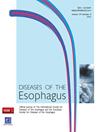393. A RADIOMICS STRATEGY BASED ON CT INTRA-TUMORAL AND PERITUMORAL REGIONS FOR PREOPERATIVE PREDICTION OF NEOADJUVANT CHEMORADIOTHERAPY FOR ESOPHAGEAL CANCER
IF 2.3
3区 医学
Q3 GASTROENTEROLOGY & HEPATOLOGY
引用次数: 0
Abstract
The standard treatment for esophageal cancer patients is neoadjuvant chemoradiotherapy followed by surgery. However, some of these patients do not achieve pathological complete response with this therapy, resulting in poor outcomes. The objective of this study is to develop a method for selecting patients who can achieve pathological complete response through pre-neoadjuvant therapy chest-enhanced CT scans. The study enrolled 201 patients with esophageal cancer and divided them into a training set and a testing set in a 7:3 ratio. Radiomics features of intra-tumoral and peritumoral images were extracted from preoperative chest-enhanced CT scans of these patients. The features underwent dimensionality reduction in two steps, using Student’s t-test and least absolute shrinkage and selection operator. The selected intra-tumoral and peritumoral (including marginal and adjacent ROI) features were used to build models with four machine learning classifiers. The models with satisfactory accuracy and stability levels were considered to perform well. Finally, the performance of these well-performing models on the testing set was displayed using ROC curves. Among the 16 models, the best-performing models were the integrated (intra-tumoral and peritumoral features) -XGBoost and integrated-random forest models. In the training set, the two models had average ROC AUCs of 0.906 and 0.918 respectively, with relative standard deviations (RSDs) of 6.26 and 6.89. In the testing set, the AUCs were 0.845 and 0.871, respectively. There was no significant difference in the ROC curves between the two models. The addition of peritumoral radiomics features to the radiomics analysis may improve the predictive performance of pathological response for esophageal cancer patients to neoadjuvant chemoradiotherapy. The integrated (intra-tumoral and peritumoral features) -XGBoost and integrated-random forest models developed in this study show potential for predicting pathological complete response in esophageal cancer patients and may help in selecting patients for neoadjuvant therapy.393.一种基于CT肿瘤内和肿瘤周围区域的放射组学策略,用于食管癌新辅助放化疗的术前预测
食管癌症患者的标准治疗方法是新辅助放化疗,然后进行手术。然而,这些患者中的一些人没有通过这种治疗获得病理学上的完全反应,导致不良结果。本研究的目的是开发一种方法,选择能够通过新辅助治疗前胸部增强CT扫描获得病理完全反应的患者。该研究招募了201名癌症食管癌患者,并将他们按7:3的比例分为训练组和测试组。从这些患者术前胸部增强CT扫描中提取肿瘤内和肿瘤周围图像的放射组学特征。使用Student t检验和最小绝对收缩和选择算子,分两步对特征进行降维。所选择的肿瘤内和肿瘤周围(包括边缘和邻近ROI)特征用于构建具有四个机器学习分类器的模型。具有令人满意的精度和稳定性水平的模型被认为表现良好。最后,使用ROC曲线显示了这些性能良好的模型在测试集上的性能。在16个模型中,表现最好的模型是综合(肿瘤内和肿瘤周围特征)-XGBost和综合随机森林模型。在训练集中,两个模型的平均ROC AUC分别为0.906和0.918,相对标准偏差(RSD)分别为6.26和6.89。在测试集中,AUC分别为0.845和0.871。两个模型之间的ROC曲线没有显著差异。在放射组学分析中添加肿瘤周围放射组学特征可以提高癌症患者对新辅助放化疗的病理反应的预测性能。本研究中开发的整合(肿瘤内和肿瘤周围特征)-XGBoost和整合随机森林模型显示了预测食管癌症患者病理完全反应的潜力,并可能有助于选择新辅助治疗的患者。
本文章由计算机程序翻译,如有差异,请以英文原文为准。
求助全文
约1分钟内获得全文
求助全文
来源期刊

Diseases of the Esophagus
医学-胃肠肝病学
CiteScore
5.30
自引率
7.70%
发文量
568
审稿时长
6 months
期刊介绍:
Diseases of the Esophagus covers all aspects of the esophagus - etiology, investigation and diagnosis, and both medical and surgical treatment.
 求助内容:
求助内容: 应助结果提醒方式:
应助结果提醒方式:


